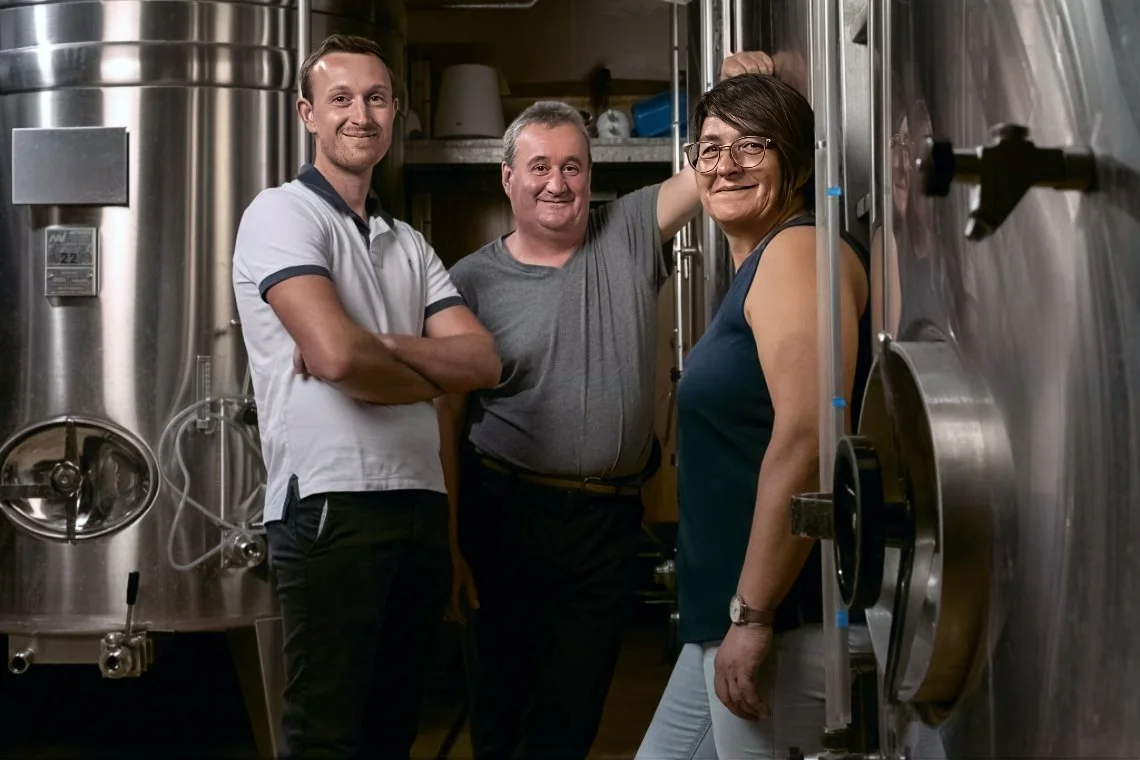Domaine de la Côte de Fasse
Beine, Chablis
The Gagnepain family has been crafting wine in Chablis for several generations, a dedication famously recognised when great-grandfather André Alix of Beine was awarded a silver medal by the Agricultural and Viticultural Society of the Arrondissement of Auxerre at the Concours de Chablis on 11 August 1907, “for his services and good conduct.” While the family’s winemaking story stretches far back, the estate as it exists today began in 1991, when Françoise Gagnepain, alongside her children Laurent and Isabelle, replanted the first vineyards around the charming village of Beine. From these modest beginnings, the estate grew steadily, eventually encompassing 14.5 hectares, dedicated to Petit Chablis and Chablis, producing wines that capture the purity, minerality, and clarity of Chablis’ unique terroir.
In 2016, the next generation joined the fold when Paul Gagnepain, Laurent’s son, became part of the team. His arrival marked a period of diversification and expansion: the estate acquired a Chablis Premier Cru plot in 2017 and planted Pinot Noir in 2018, to produce Bourgogne red and rosé. Looking ahead, the estate plans to introduce Aligoté and Sauvignon Blanc, continuing the evolution of its grape varieties and further expressing the richness of Chablis’ terroirs. By 2022, the domaine had grown to approximately 21 hectares, now producing a broad range of wines, from Petit Chablis and classic Chablis to Premier Cru, Crémant de Bourgogne, and Bourgogne red and rosé.
Sustainability is at the heart of the domaine’s philosophy. Operating under High Environmental Value (HVE) Level 3 certification, Domaine de la Côte de Fasse manages its vineyards with care, promoting biodiversity, reducing chemical inputs, and ensuring long-term stewardship of the land. This respect for the vineyard extends into the cellar, where winemaking is guided by precision, minimal intervention, and a commitment to showcasing the clarity, freshness, and mineral character of each site.
Today, Domaine de la Côte de Fasse reflects both heritage and innovation, with each release from Petit Chablis to Premier Cru telling the story of place, family, and tradition, offering wines of balance, elegance, and authenticity.








2022 Petit Chablis
The Petit Chablis comes from the estate’s higher-altitude vineyards around Beine, planted on Kimmeridgian limestone and clay-limestone soils that give the wine its lift and freshness. The vines are carefully tended to ensure low yields and optimal ripeness, and hand-harvesting preserves the integrity of the fruit.
Winemaking
Grapes are hand-picked and gently pressed using a pneumatic press. The juice is cold-settled at around 10°C without enzymes, then fermented in stainless steel vats at 13–14°C over two to three weeks. The wine is kept on fine lees for four to six months to enhance texture and mouthfeel, then gently filtered before bottling. This approach preserves the wine’s purity, freshness, and delicate mineral character.
Tasting Note
Pale straw in colour, the wine displays aromas of citrus, green apple, and subtle white flowers. The palate is crisp and refreshing, with a delicate mineral backbone and fine length. Light, precise, and approachable, this Petit Chablis reflects the charm and clarity of its northern Chablis terroir.
2023 Chablis
This Chablis is drawn from the estate’s core village vineyards, planted on Kimmeridgian limestone soils that give the wine depth and a signature flinty minerality. Vines are carefully managed to balance yield and concentration, with hand-harvesting ensuring optimal selection of the fruit.
Winemaking
Hand-harvested grapes are gently pressed and the juice cold-settled at 10°C without enzymes. Fermentation takes place in temperature-controlled stainless steel vats at 13–14°C over three to four weeks. Partial malolactic fermentation is carried out depending on the vintage, and the wine is aged on fine lees for six to eight months to build texture while maintaining freshness. Gentle filtration preserves clarity before bottling.
Tasting Note
Pale gold in the glass, the wine opens with aromas of green apple, pear, lemon zest, and wet stone. The palate is precise, mineral-driven, and balanced, with hints of almond and saline character adding depth. Elegant and versatile, this Chablis pairs beautifully with seafood, white meats, and lightly sauced dishes.
2023 Chablis Premier Cru ‘Vau De Vey’
Sourced from the Premier Cru ‘Vau de Vey’ vineyard, this wine comes from steep, south-facing slopes with Kimmeridgian limestone soils, delivering intensity, structure, and age-worthy potential. The vines are carefully pruned and yields controlled to ensure concentration and balance.
Winemaking
Grapes are hand-picked and gently pressed, with the juice cold-settled at 10°C without enzymes. Fermentation occurs in stainless steel vats at 13–14°C over three to four weeks. Malolactic fermentation is selectively carried out, followed by ageing on fine lees for 10–12 months to develop texture and complexity. The wine is gently filtered before bottling, preserving the minerality and precision of the site.
Tasting Note
Pale gold with expressive aromas of citrus, white orchard fruit, and subtle white flowers layered over flinty minerality. The palate is structured and layered, with chalky minerality, depth, and a long, elegant finish. Powerful yet refined, this Premier Cru Chablis showcases the character of Vau de Vey and is well-suited to seafood, lobster, creamy sauces, and dishes with richer textures.




